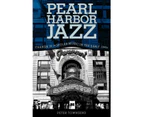Pearl Harbor Jazz: Changes in Popular Music in the Early 1940s

Pearl Harbor Jazz: Change in Popular Music in the Early 1940s
by Peter Townsend.
This book is a study of a crucial period in the life of American jazz and popular music. Pearl Harbor Jazz analyzes the changes in the world of the professional musician brought about both by the outbreak of World War II and by long-term changes in the music business, in popular taste, and in American society itself. It describes how the infrastructure of American music-the interdependent fields of recording, touring, live engagements, radio, and the movies-was experiencing change in the conditions of wartime and how this impacted upon musical styles and hence upon the later history of popular music. Successive chapters of the book examine the impact of these changed conditions upon the songwriting and music publishing industries, upon the world of the touring big bands, and upon changing conceptions of the role of jazz and popular music.
Not only the economic conditions, but also ideas were changing. The book traces a movement among writers and critics which created new definitions of "jazz" and other terms that had a permanent influence on the way musical styles were thought of for the rest of the century. The book deals in some depth with the work of a number of important artists in these various fields, including Duke Ellington, Charlie Parker, Johnny Mercer, and Frank Sinatra. It also looks at the growing presence of bebop, the rise of country music, and the contemporary musical scenes in such locations as New York and Los Angeles. The book combines detail of the day-to-day working lives of musicians with challenging views of the long-term development of musical style in jazz and popular music.
Peter Townsend lectures at Manchester Metropolitan University and in the School of Music at the University of Huddersfield, England.
Publisher: Rethink Press
Published: United States, 19 December 2006
Format: Paperback / softback, 256 pages
Age Range: 15+
Dimensions: 22.9 x 15.2 x 1.6 centimeters (0.41 kg)
Writer: Townsend, Peter
About the AuthorPeter Townsend lectures at Manchester Metropolitan University and in the School of Music at the University of Huddersfield, England
ReviewsIn this comprehensive period study, Townsend (a British scholar) tackles the thorniest issues plaguing jazz scholarship: differences in conditions between black and white bands (in this case during a particular time period), the cross-fertilization of jazz and other popular musics, and critical acclaim versus commercial success. The swing era blossoms organically out of Townsend's detailed description of the status of the music business just prior to the event that plunged the US into WW II. As wartime shortages--evidenced, for example, by gas rationing and the famous recording ban--begin to interfere with the venues that contributed to the widespread popularity of the big bands, the era drops its petals, one at a time. Not succumbing to the temptation to focus exclusively on the war's impact on the development of jazz, Townsend takes each new challenge brought on by the war and compares its influence across all musical entertainment options. Anyone interested in American music should read this work in order to place events in their historical context; and anyone interested in American history should read it to understand how music shapes--and is shaped by--the time in which it is created. Summing Up: Essential. All readers; all levels. Choice CHOICE Outstanding Academic Title 2008
